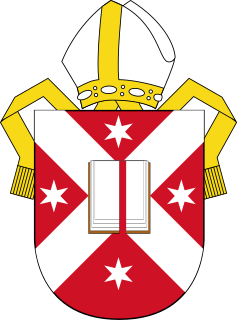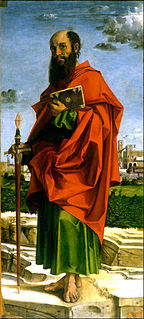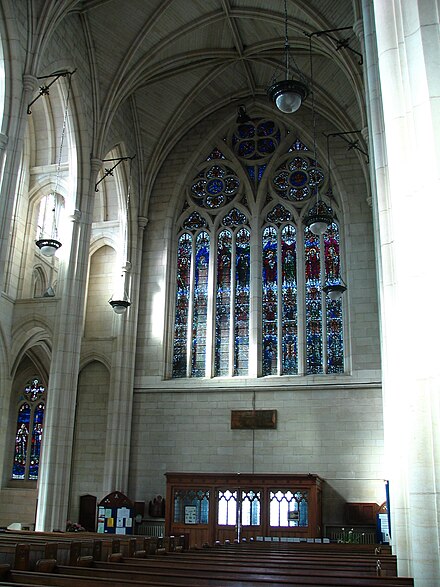
The Metropolitan Cathedral Church of Saint Andrew or Glasgow Metropolitan Cathedral is a Roman Catholic Cathedral in the city centre of Glasgow, Scotland. It is the mother church of the Roman Catholic Archdiocese of Glasgow. The Cathedral, which was designed in 1814 by James Gillespie Graham in the Neo Gothic style, lies on the north bank of the River Clyde in Clyde Street. St Andrew's Cathedral is the seat of the Archbishop of Glasgow, currently the Most Reverend Philip Tartaglia. It is dedicated to the patron saint of Scotland, Saint Andrew.

St Mary's Church, Rotherhithe, is the local Church of England parish church in Rotherhithe, formerly in Surrey and now part of south east London. The parish is now within the diocese of Southwark and under the jurisdiction of the Bishop of Fulham. The 18th-century church is in St Marychurch Street and is dedicated to Mary, mother of Jesus, and it is particularly proud of its connections with the Pilgrim Fathers. It remains a living and working church, supported by local people and serving a broad community.
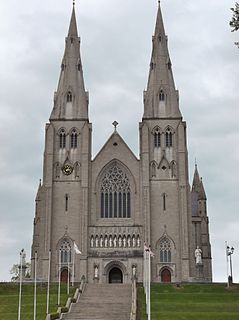
St. Patrick's Cathedral in Armagh, Northern Ireland is the seat of the Catholic Archbishop of Armagh, Primate of All Ireland. It was built in various phases between 1840 and 1904 to serve as the Roman Catholic Cathedral of the Archdiocese of Armagh, the original Medieval Cathedral of St. Patrick having been transferred to the Protestant Church of Ireland at the time of the Irish Reformation.

The Minster and Parish Church of St George, Doncaster, also known as Doncaster Minster, is a parish church in the Church of England. It is one of the Greater Churches.

All Saints' Church, Northampton situated in the centre of Northampton, is a Parish Church of the Church of England and Northampton's Civic Church. It is a Grade I listed building.

The Boardwalk Hall Auditorium Organ is the pipe organ in the Main Auditorium of the Boardwalk Hall in Atlantic City, New Jersey, built by the Midmer-Losh Organ Company. It is the largest organ in the world, as measured by the number of pipes.
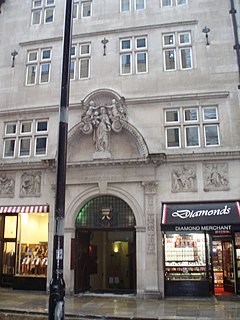
St Mary Moorfields is a Roman Catholic church in Eldon Street near Moorgate, on a site previously known as Moorfields. It is the only Catholic church in the City of London. Prior to 1994, the church was designated as being in the Borough of Hackney, such that there were no Catholic churches in the City.

The Grand Organ situated in the Royal Albert Hall in London is the second largest pipe organ in the United Kingdom. It was originally built by Henry "Father" Willis and most recently rebuilt by Mander Organs, having 147 stops and 9,997 speaking pipes.
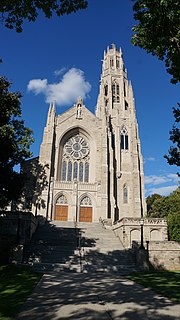
The Cathedral Basilica of Christ the King is a Roman Catholic church in Hamilton, Ontario, Canada. The cathedral was consecrated on December 19, 1933. It is the seat of the Bishop of the Diocese of Hamilton, and the cathedral of the Diocese of Hamilton. The cathedral contains the cathedra of the Bishop, the Most Rev. Douglas Crosby. The cathedral was raised to the status of a minor basilica in February 2013 by Pope Benedict XVI.
Samuel Tarratt Nevill was the first Anglican Bishop of the Diocese of Dunedin in Dunedin, New Zealand.

The pipe organ is played from an area called the console or keydesk, which holds the manuals (keyboards), pedals, and stop controls. In electric-action organs, the console is often movable. This allows for greater flexibility in placement of the console for various activities. Some very large organs, such as the van den Heuvel organ at the Church of St. Eustache in Paris, have more than one console, enabling the organ to be played from several locations depending on the nature of the performance.
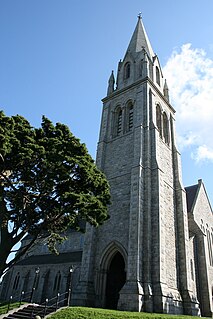
Christ Church, Bray is in the Church of Ireland parish of Bray, County Wicklow located on Church Road on a rise, previously known as the Rock of Bray, behind Bray Town Hall.
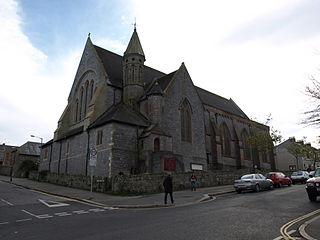
All Saints' Church, Falmouth is a parish church in the Church of England Diocese of Truro located in Falmouth, Cornwall, United Kingdom.

St Peter and St Paul is a church in the town of Bromley, Borough of Bromley, in south east London. Known familiarly as Bromley Parish Church, it is not far from Bromley High Street and approximately halfway between Bromley North and Bromley South railway stations. The church is part of the Diocese of Rochester within the Church of England. Largely destroyed by bombing during the Second World War, St Peter and St Paul was rebuilt in the 1950s. It has been Grade II* listed since 1955.

St Anne's Church is in Church Road, Singleton, Lancashire, England. It is an active Anglican parish church in the deanery of Poulton, the archdeaconry of Lancaster, and the Diocese of Blackburn. Its benefice is united with those of St Chad, Poulton, and St Hilda, Carleton. It is recorded in the National Heritage List for England as a designated Grade II listed building.

The Church of Saint Colman is a Roman Catholic parish church in the parish of Claremorris and Barnacarroll. It designed in Early English Gothic by R. M. Butler and built in 1911. It is located in the centre of Claremorris, Co. Mayo, Ireland.
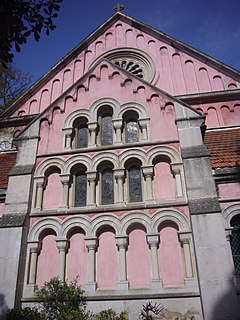
St George's Church is the only English-speaking Anglican congregation in Lisbon, Portugal. It is at Rua São Jorge 6, north of the Estrela Garden.
The Brindley organ in St Mary's Church, Tickhill, Yorkshire, England is a Victorian instrument influenced by the German organ building tradition.

St Mary's Church is the Church of England parish church of Haddenham, Buckinghamshire. It is a Grade I listed building.

Casavant Frères Ltée. Opus 1841 is a pipe organ built by the famous Casavant Frères of Saint-Hyacinthe, Quebec. The organ was first completed in 1911 as Casavant Brothers - Opus 452 for St. Andrew's Presbyterian Church at 40 Bentinck Street, Sydney, Nova Scotia, Canada. St. Andrew's later became St. Andrew's United Church and is now the Highland Arts Theatre.

